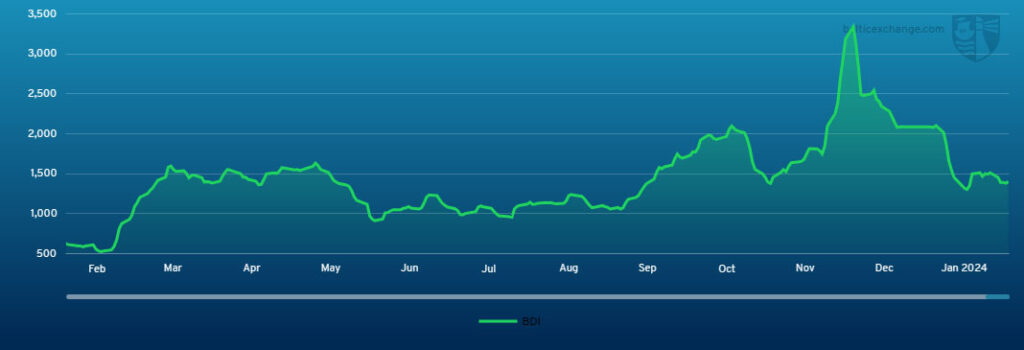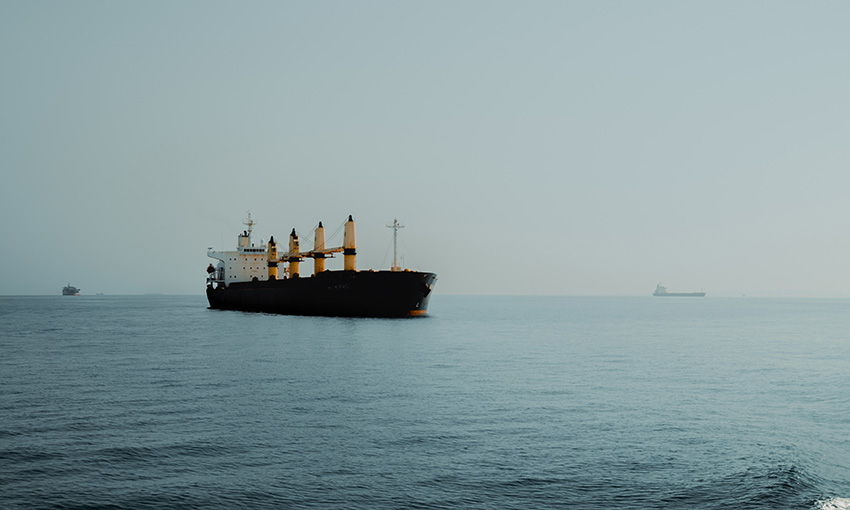THE BALTIC Dry Index dipped slightly throughout this past week before increasing to 1407 on Friday (2 February).

Capesize
Throughout the week, the capesize market experienced a mix of subdued and positive conditions across different regions. The Pacific started with a marginal decline in rates on C5 due to a lack of coal enquiry and port closures in North China causing uncertainty. As the week progressed there was an increase in volumes including coal enquiry from East Coast Australia to China but rates on C5 continued to decline.
By mid-week there was a positive turn in the Pacific and South Atlantic, with the BCI 5TC experiencing a notable increase, attributed to a longer cargo list in the Pacific and the resurgence of coal in the market, while further port closures in North China added complexity. In the Atlantic, a shift towards positional conditions was noticeable, especially from South Brazil and West Africa. Premiums were being paid for tonnage capable of arriving within February.
Towards the end of the week the Pacific remained relatively active, there were signs of resistance from owners, leading to a slight uptick in C5 rates. Whilst in the Atlantic conditions varied, with South Brazil and West Africa to the Far East remaining relatively quiet, with a widening bid / offer spread and the north Atlantic facing tight conditions with limited enquiry. The week concluded on a subdued note, with the BCI 5TC seeing an uptick of US$884 reaching a closing value of US$16,837.
Panamax
It proved to be another week of steady declines for the Panamax market. With a heavy ballaster list and increased tonnage count, resistance from owners was mostly scarce. This resulted in charterers driving down bids, especially in the Atlantic region with Asia also witnessing a similar trend.
In the Atlantic, aside from mid-February arrival EC South America grain demand in the early part, it has been lacklustre with both P1A and P2A routes lacking mostly. From South America US$18,250 + US$825,000 bb reported fixed several times delivery Aps load port Mid-February but the focus now was for end February where less pressure with Charterers adopting a more relaxed approach. In Asia, the market saw similar declines with tonnage severely outweighing demand. With a weak and pessimistic EC South America market Southeast Asia positions saw little joy. Rates for the limited coal to India trades were discounted by most with many looking to reposition.
Ultramax/Supramax
A rather mixed affair this week, which was generally seen as positional. The Atlantic saw a bit of increased demand from the US Gulf for fronthaul business and with tonnage remaining relatively tight, rates increased. From the South Atlantic a rather lacklustre week ensued although rates generally remained around last done. From Asia, very little fresh enquiry was seen from Indonesia adding to owners’ woes with limited fresh activity further north. The only bright areas seemed to be the Indian Ocean where rates remained healthy. Period interest remained, a 55,000-dwt open Campha fixing three to five months trading redelivery worldwide at US$13,200. In the Atlantic a 61,000-dwt open US Gulf was heard fixed for a trip to South Korea at US$26,500. Elsewhere, a 56,000-dwt open United Kingdom fixed a scrap run to the East Mediterranean at US$15,500. From Asia, came the news a 57,000-dwt fixed delivery Koh Sichang for a trip China at US$7,000. However, from the Indian Ocean a 63,000-dwt fixed delivery East London for a trip to the Far East at US$22,000 plus US$220,000 ballast bonus.
Handysize
A rather subdued week across the handy sector which saw limited visible activity across both basins. The US Gulf continued to experience a lack of cargo enquiry, with a 38,000-dwt fixing from SW Pass to EC Mexico with an intended cargo of grains at US$12,500 whilst a 36,000-dwt was fixed from SW Pass to Ireland with also with grains at a rate close to US$12,000. The South Atlantic saw the recent upward trend stall, with limited enquiry remaining for the first half of February. In the Mediterranean a 30,000-dwt fixed basis passing Canakkale via the Black Sea to Algeria with grains at US$11,000 whilst a 38,000-dwt was rumored to have fixed from Damietta to the US Gulf NC South America at US$10,900. In Asia, with the impending Chinese New Year holidays, fresh enquiry was said to be scarce, and opportunities limited for Owners. A 38,000-dwt was rumored to have been fixed from Singapore via Australia to China with Alumina at US$8,500.
Clean
LR2
LR’s in the MEG lost some steam this week and freight rates took a downturn. The 75kt MEG/Japan TC1 index dropped 31.66 points to WS322.78. The 90kt MEG/UK-Continent TC20 run to the UK-Continent also came down US$212,500 to US$8.475 million.
West of Suez, Mediterranean/East LR2’s on TC15 saw a significant upturn, the index climbed US$641,000 to US$5.608 million.
LR1
In the MEG, LR1 freight has also taken a tumble. The 55kt MEG/Japan index of TC5 is currently marked at WS356.13, down 21.68 points. The 65kt MEG/UK-Continent of TC8 hovered around the US$7.2 million to US$7.4 million mark all week.
On the UK-Continent, the 60kt ARA/West Africa TC16 index saw a big upturn mid-week after a market reported fixture at WS245. This has taken the index up to its current mark of WS243.81, a gain of 38.87 points.
MR
MRs in the MEG have taken a significant re-correction down this week, the TC17 index shed 26.42 points to WS445.71 with reports of WS425 on subjects in the market at time of writing.
UK-Continent MRs have been reportedly soft this week with charterers in the driving seat. As a result 37kt ARA/US-Atlantic coast of TC2 index lost 61.39 points (26% of its value) and is currently marked at WS164.64. This has taken the Baltic round trip TCE for TC2 down from US$28,000 / day round trip to US$16,000 /day, a 42% drop. On a TC19 run (37kt ARA/West Africa) the index has followed suit of TC2 and dropped from WS246.88 to WS184.38 this week.
The USG MRs followed a peak and trough pattern this week. TC14 (38kt US-Gulf/UK-Continent) went from WS164.29 to WS176.07 and then back to WS164.64. The 38kt US Gulf/Brazil on TC18 mirrored this, peaking at WS225 from WS215 to then return back to WS218.57 by end of the week. The 38kt US-Gulf/Caribbean TC21 steadily ticked down this week from US$715,000 to US$696,429.
Handymax
In the Mediterranean, Handymax’s showed a steep downward trajectory and the TC6 index went from WS307.78 to WS245.
Up in North West Europe, the TC23 30kt Cross UK-Continent index had 96.39 points cut from it this week falling to WS225.83.
VLCC
The market was mostly static this week with the rate for the 270,000 mt Middle East Gulf to China route hovering around the WS57.5 to WS58 level. This translates into a daily round-trip TCE of about US$33,500 basis the Baltic Exchange’s recently updated vessel description.
In the Atlantic market, a similar situation was experienced for the 260,000 mt West Africa/China trip where the rate was held at the WS59 to WS59.5 mark which shows a round voyage TCE of about US$35,500 per day) while the rate for 270,000 mt US Gulf/China slipped US$122,222 to US$8,811,111 (which provides a round-trip daily TCE of US$42,245).
Suezmax
Suezmaxes in West Africa were slightly weaker this week with the rate for 130,000 mt Nigeria/UK Continent three points softer than last Friday at WS105.55 (a daily round-trip TCE of US$39,583). In the Mediterranean and Black Sea region the rate for 135,000 mt CPC/Med remained steady at a fraction below WS130 (showing a daily TCE of a little above US$53,500 round-trip). In the Middle East, the rate for 140,000 mt Middle East Gulf to the Mediterranean was lifted eight points to WS123.78 with the continued risks involved in a Red Sea transit being the main driving force behind the rise.
Aframax
In the North Sea, the rate for the 80,000 mt Cross-UK Continent route fell eight points to WS173.70 (showing a round-trip daily TCE of US$65,589 basis Hound Point to Wilhelmshaven).
In the Mediterranean market the rate for 80,000 mt Cross-Mediterranean has weakened again, by almost 18 points since last Friday to WS195.39 (basis Ceyhan to Lavera, that shows a daily round trip TCE of US$60,792).
Across the Atlantic, the Stateside market has continued on a downward spiral. The rate for 70,000 mt East Coast Mexico/US Gulf (TD26) and 70,000 mt Covenas/US Gulf (TD9) both had 52.5 points deducted from last Friday’s assessments, to WS213.13 (a round-trip TCE of US$59,500 per day) and WS204.38 (a round-trip TCE of US$49,846 per day) respectively. The rate for the trans-Atlantic route of 70,000 mt US Gulf/UK Continent (TD25) is now 19 points weaker at WS185.31 (a round trip TCE basis Houston/Rotterdam of US$43,648 per day).
LNG
The main piece of news on the lips of the LNG community this week was the shock announcement from the US administrations on a temporary pause in awarding export permits for potential LNG liquefaction projects. The impact not initially seen, could be far reaching in terms of volume, and with many ships due to come onto the water a drop in volume could harm freight rates quite significantly. Meanwhile, it is business as usual for the LNG spot market, some reversal of the downward trend seen of late begun with the influx of cargoes out in Australia but with one going cheap, it couldn’t stimmy a further drop. Rates for BLNG1 Aus-Japan fell on both the 160cbm and 174cbm with the routes publishing at US$35,390, and US$52,526 respectively. The Atlantic was busy as well with several cargoes worked and eating into a longer tonnage list, but with fixing windows quite far out there wasn’t enough appetite to change the tide and rates remained flat.
BLNG2 US-Cont finished up on the 160cbm at US$39,118, while the 174cbm lost a small percentage to close at US$51,147. BLNG3 US-East couldn’t shake off the doldrums and both the 160cbm and 174cbm ships closed lower, with the 160cbm at US$39,131 while the 174cbm finished at US$49,145.
Period softened again with little reported, the six month TC on a 174cbm dropped US$5200 to US$52,700 while one Year and three year TC closed at US$74,067 and US$88,000 respectively.
LPG
There is not much positive news to write about on this week’s BLPG, though brokers have reported fixtures (similar in numbers to the same time last year) the routes have all continued to suffer. With BLPG1 Ras Tanura-Chiba falling US$8.857 (a drop of 21.83%) and publishing at US$31.714 we have begun to really hit the bottom. A ship failing at US$31 wasn’t beaten any lower and the ebbing tide hopefully is turning for LPG.
Across the Atlantic the BLPG2 Houston-Flushing fell by US$12.4 (-23.85%) to close at US$39.6 giving a daily TCE earning of US$28,180 per day, this has been the lowest rates seen for some time and owners are not really able to get charterers to pay up. BLPG3 Houston-Chiba has seen the biggest fall in terms of dollars but from a higher point meant overall it wasn’t the worst performing route, uncertain footing and a poor product market meant a loss of US$18.714 (20.3%) and a final publication of US$73.429 with a daily TCE earning of US$17,852.

